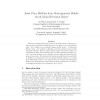Free Online Productivity Tools
i2Speak
i2Symbol
i2OCR
iTex2Img
iWeb2Print
iWeb2Shot
i2Type
iPdf2Split
iPdf2Merge
i2Bopomofo
i2Arabic
i2Style
i2Image
i2PDF
iLatex2Rtf
Sci2ools
FS
2011
2011
Asset price bubbles from heterogeneous beliefs about mean reversion rates
Harrison and Kreps showed in 1978 how the heterogeneity of investor beliefs can drive speculation, leading the price of an asset to exceed its intrinsic value. By focusing on an extremely simple market model – a finite-state Markov chain – the analysis of Harrison and Kreps achieved great clarity but limited realism. Here we achieve similar clarity with greater realism, by considering an asset whose dividend rate is a mean-reverting stochastic process. Our investors agree on the volatility, but have different beliefs about the mean reversion rate. We determine the minimum equilibrium price explicitly; in addition, we characterize it as the unique classical solution of a certain linear differential equation. Our example shows, in a simple and transparent manner, how heterogeneous beliefs about the mean reversion rate can lead to everlasting speculation and a permanent “price bubble.”
Dividend Rate | Equilibrium Price | FPGA | FS 2011 | Markov Chain |
| Added | 28 Aug 2011 |
| Updated | 28 Aug 2011 |
| Type | Journal |
| Year | 2011 |
| Where | FS |
| Authors | Xi Chen, Robert V. Kohn |
Comments (0)

